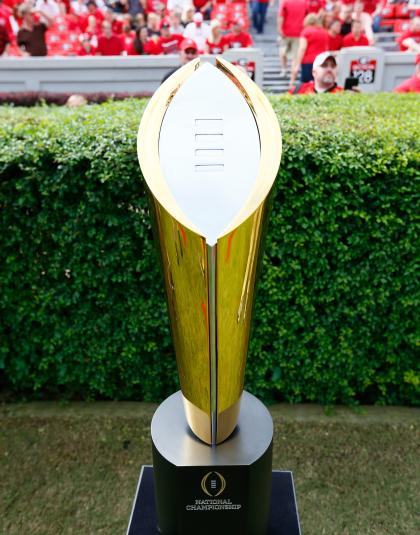College Football Playoff is good, but it could be better with more teams
If there were any lingering doubts that the death of the Bowl Championship Series was abundantly deserved, the College Football Playoff semifinals erased them.
Because here is the national title matchup the BCS would have produced this season: Alabama vs. Florida State. One was defrocked by a big underdog starting a third-string quarterback Thursday, and the other was merely beaten by 39 points.
But under the old system, a moronic marriage of poll voting and computer rankings, either the Crimson Tide or the Seminoles would be standing on a stage under a confetti shower with index fingers in the air, proclaiming themselves the best team in America. Oregon and Ohio State would have played in a hollow Rose Bowl for a far lesser prize.
How many other seasons was the best team – or two teams – excluded from contention by the BCS? Who knows? But 2001 Oregon, '03 USC, '04 Auburn and '08 Texas undoubtedly all wish a better system were in place when they were left out of the title chase.
Yet even with the upgrade to a four-team playoff, there is a compelling reason to believe the system could be better.
That reason is TCU.

Who's to say the Horned Frogs aren't the best team in the nation? They were surprisingly trap-doored by the CFP selection committee in its final rankings, plummeting from third to sixth one day after winning their final regular-season game by 52 points to finish 11-1. As a result, TCU was relegated to the Peach Bowl against Mississippi, which was ninth in the final CFP rankings.
TCU destroyed Ole Miss 42-3, despite easing off the gas and not scoring in the final 28 minutes. It was the biggest beating of the bowl season, and it left everyone wondering whether a mistake was made by snubbing the Frogs.
They lost one game by three points at the final gun on the road against a top-10 opponent. That was far better than Ohio State's two-touchdown home loss to Virginia Tech and Oregon's one-touchdown home loss to Arizona.
As it turned out, Ohio State proved the merit of its controversial inclusion in the playoff by shocking Alabama. But that plus TCU's performance shows there were more than four teams worthy of playing for a title.
(Yes, Florida State still deserves to be included in that company, despite its epic third-quarter collapse against Oregon. A playoff without an undefeated defending national champion would have been just as controversial.)
So the takeaway from the first-ever playoff semifinals is this: four is good. Six or eight would be better. In a nation of five power conferences, simple math suggests as much anyway.
There are complications with the academic calendar when it comes to scheduling an additional round of games, and even a ravenously greedy sport that has been known to make a mockery of higher education must bow to the demands of fall semester finals. But there is a way. It can be done. The smart and powerful minds of the sport got together and hammered out the current format to satisfy public demand; they can do it again.
Tear up the TV contracts and remake the playoff.
While we are patiently waiting for that to happen, we can turn our attention to the championship matchup of Ducks vs. Buckeyes. After dismantling its ninth straight opponent, Oregon is a deserving favorite. But anyone who has watched Ohio State continually reinvent its offense this season knows better than to count out Urban Meyer.

There may be some historical precedent for a team achieving this much while digging all the way to the third rung on the depth chart at the most important position in football, but it escapes me at present. What the Buckeyes are doing with Cardale Jones – who has thrown for 500 yards and four touchdowns in the only two significant appearances of his college career – boggles the mind. At this point you half expect Meyer to be able to start the sousaphone player who dots the "i" in Script Ohio at quarterback and still score 40.
But this time Jones and Ohio State run up against the best quarterback in college football in Marcus Mariota. The Heisman Trophy winner was routinely excellent against Florida State, accounting for exactly 400 yards of total offense and three touchdowns in leading an Oregon offense that punted just twice – its first and last full possessions of the game.
It should be a fun and fascinating matchup.
The big question is what it will feel like – because the semifinal games, as big as they were, seemed to be missing something. They were neither fish nor fowl – not a national championship game and not an old-school bowl game. It will take some getting used to.
As will the notion of getting back to a mental and emotional peak for a massive elimination game. That's the essence of the NCAA basketball tournament – survive and advance – but a new concept in football, and it will be interesting to see how hard that is. It's all new for the players and coaches, who at least have the benefit of 11 days between games to lock in and ramp up.
"It's all or nothing," said former Texas coach and current ESPN analyst Mack Brown, the day before the Rose Bowl. "And for the winner it's all or nothing again the next week."
Thankfully, there is another all-or-nothing game to crown a truer champion than the BCS would have produced. But with a playoff that still isn't big enough, we don't know for sure that it will be the truest champion.
